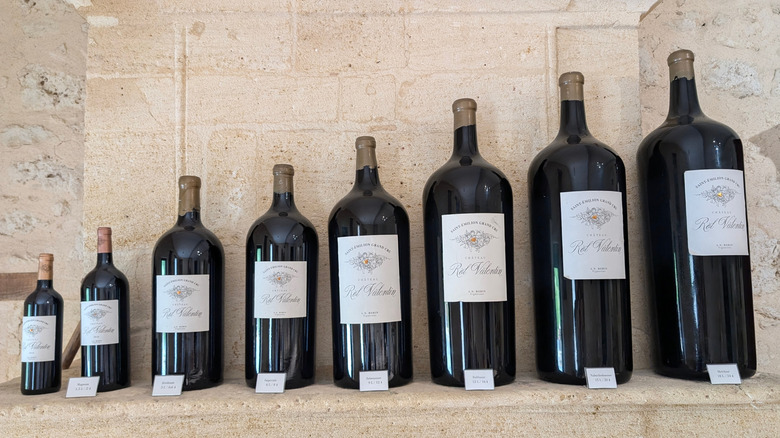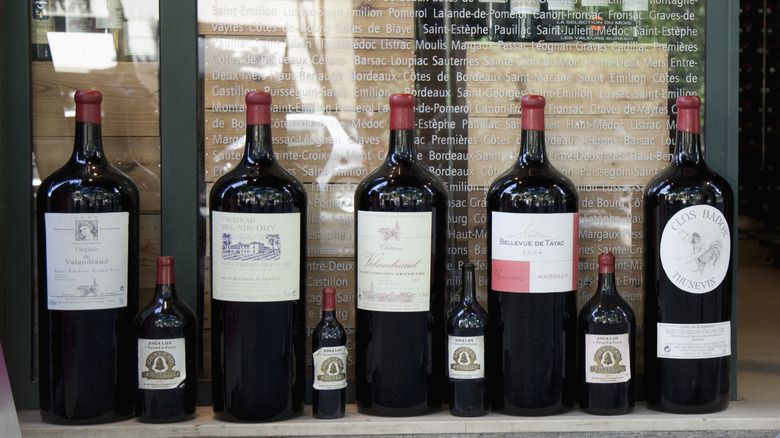What's The Biggest Size Bottle Of Wine And How Many Glasses Can It Fill?
You're likely familiar with the standard 750-milliliter bottle that most people would have in their homes. But, that's only the beginning (well, more like the middle). Although that 750-milliliter bottle is the most common, it's only one of a large collection of bottle sizes. It starts with a piccolo, also called a split, and goes all the way up to the Melchizedek.
The Melchizedek, which also goes by the less common (but equally monarchical) moniker Midas, holds 30 liters of wine. That equals about 200 glasses, compared with a standard bottle's measly five glasses of wine. The gargantuan vesself, equivalent to 40 standard bottles, is most often associated with Champagne, but it's also been used for grand vin and special releases in Bordeaux and Burgundy. As such, the price on these bottles varies as much as any wine. Since the bottle itself can cost around $2,000 to manufacture, expect a starting price tag of more than $7,000.
Why buy a Melchizedek bottle
That's a lot of money on the line, so there's got to be a case for large-format wine and a good reason to drop several thousand bucks on one bottle. On the one hand, bottles that big are pretty impressive to look at and can be a majestic and exciting way for a crowd to celebrate an important occasion, like a wedding or anniversary. If you're sure that 200 of your closest friends would like the same style of wine, it's also an easy way to serve the masses.
Even beyond the obvious symbol of status and festivity, though, large bottles of wine — anything from the 1 ½-liter magnum to the 15-liter Nebuchadnezzer and beyond — do have a practical application. Compared with standard bottles, large-format bottles have a smaller air-to-wine ratio because the space between the cork and the wine is the same size as in a standard bottle. That means that the wine will take longer to oxidize and age, helping protect the bottle of wine from going bad. The aging process is particularly slowed in sparkling wines.
The bottle itself is useful, too. The extra-thick glass required for a large-format bottle adds another layer of protection against harsh light and harmful movement, while the greater volume of wine protects against high or changing temperatures. So, even the Melchizedek's price might just be worth the investment.
Bottle names of biblical proportions
Melchizedek is a wine bottle that requires a special mechanism just to pour, so it stands to reason that both its namesakes would be royalty. Melchizedek is a king and priest from the Hebrew Bible who presented bread and wine to the prophet Abraham after a great victory, a celebration that would become the inspiration for generations of monarchs displaying their triumph. Midas is Greek mythology's king of Phrygia. In his avarice, Midas wished for the ability to turn everything he touched into gold — which, unsurprisingly, didn't turn out well. When the king's food and wine also got the Midas touch, he had to turn to god of wine Dionysus for his salvation.
Despite the loose wine connections present in both these royal stories, the impetus behind the bottle's christening is murky, like many myths about wine. The same goes for the biblical theme behind a lot of the large-format wine bottles. After magnum, you'll find appellations like Jeroboam (two different Israelite kings) and Methuselah (the 969-year-old biblical patriarch). Why is unclear. Old English terms might have something to do with it, as might the attributes of the biblical characters, like Methuselah's aging. But, it could just be a desire to give the bottles a royal connotation fit for their imperial sizes.



